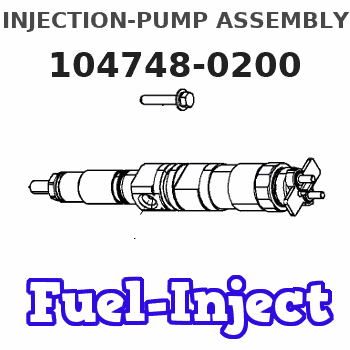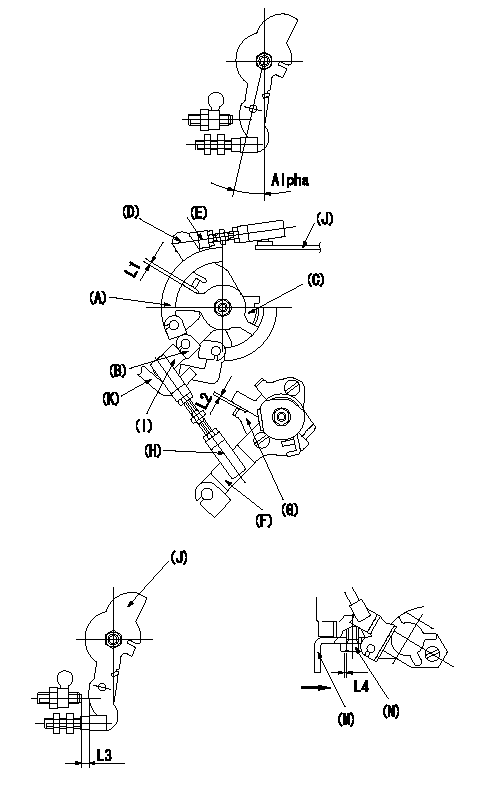Information injection-pump assembly
ZEXEL
104748-0200
1047480200
MAZDA
RF3513800
rf3513800

Rating:
Cross reference number
ZEXEL
104748-0200
1047480200
MAZDA
RF3513800
rf3513800
Zexel num
Bosch num
Firm num
Name
Calibration Data:
Adjustment conditions
Test oil
1404 Test oil ISO4113orSAEJ967d
1404 Test oil ISO4113orSAEJ967d
Test oil temperature
degC
45
45
50
Nozzle
105000-2010
Bosch type code
NP-DN12SD12TT
Nozzle holder
105780-2080
Opening pressure
MPa
14.7
14.7
15.19
Opening pressure
kgf/cm2
150
150
155
Injection pipe
Inside diameter - outside diameter - length (mm) mm 2-6-840
Inside diameter - outside diameter - length (mm) mm 2-6-840
Transfer pump pressure
kPa
20
20
20
Transfer pump pressure
kgf/cm2
0.2
0.2
0.2
Direction of rotation (viewed from drive side)
Left L
Left L
Injection timing adjustment
Pump speed
r/min
1375
1375
1375
Average injection quantity
mm3/st.
35.9
35.4
36.4
Difference in delivery
mm3/st.
2.5
Basic
*
Injection timing adjustment_02
Pump speed
r/min
2600
2600
2600
Average injection quantity
mm3/st.
12.8
9.8
15.8
Injection timing adjustment_03
Pump speed
r/min
2325
2325
2325
Average injection quantity
mm3/st.
31.2
29.2
33.2
Injection timing adjustment_04
Pump speed
r/min
1375
1375
1375
Average injection quantity
mm3/st.
35.9
34.9
36.9
Injection timing adjustment_05
Pump speed
r/min
600
600
600
Average injection quantity
mm3/st.
31.1
29.1
33.1
Injection quantity adjustment
Pump speed
r/min
2600
2600
2600
Average injection quantity
mm3/st.
12.8
10.8
14.8
Difference in delivery
mm3/st.
4
Basic
*
Injection quantity adjustment_02
Pump speed
r/min
2700
2700
2700
Average injection quantity
mm3/st.
6
Governor adjustment
Pump speed
r/min
350
350
350
Average injection quantity
mm3/st.
8
6
10
Difference in delivery
mm3/st.
2
Basic
*
Governor adjustment_02
Pump speed
r/min
350
350
350
Average injection quantity
mm3/st.
8
6
10
Timer adjustment
Pump speed
r/min
100
100
100
Average injection quantity
mm3/st.
42
42
Basic
*
Speed control lever angle
Pump speed
r/min
350
350
350
Average injection quantity
mm3/st.
0
0
0
Remarks
Magnet OFF
Magnet OFF
0000000901
Pump speed
r/min
1375
1375
1375
Overflow quantity
cm3/min
410
278
542
Stop lever angle
Pump speed
r/min
1375
1375
1375
Pressure
kPa
460.5
431
490
Pressure
kgf/cm2
4.7
4.4
5
Basic
*
Stop lever angle_02
Pump speed
r/min
600
600
600
Pressure
kPa
245.5
216
275
Pressure
kgf/cm2
2.5
2.2
2.8
Stop lever angle_03
Pump speed
r/min
1375
1375
1375
Pressure
kPa
460.5
431
490
Pressure
kgf/cm2
4.7
4.4
5
Stop lever angle_04
Pump speed
r/min
2325
2325
2325
Pressure
kPa
706
677
735
Pressure
kgf/cm2
7.2
6.9
7.5
0000001101
Pump speed
r/min
1375
1375
1375
Timer stroke
mm
4.7
4.5
4.9
Basic
*
_02
Pump speed
r/min
1375
1375
1375
Timer stroke
mm
4.7
4.4
5
_03
Pump speed
r/min
2000
2000
2000
Timer stroke
mm
8.4
7.8
9
_04
Pump speed
r/min
2325
2325
2325
Timer stroke
mm
9.7
9.1
10.3
0000001201
Max. applied voltage
V
8
8
8
Test voltage
V
13
12
14
0000001401
Pump speed
r/min
1375
1375
1375
Average injection quantity
mm3/st.
28.2
27.2
29.2
Timer stroke TA
mm
4.1
3.9
4.3
Basic
*
_02
Pump speed
r/min
1375
1375
1375
Average injection quantity
mm3/st.
28
26.5
29.5
Timer stroke TA
mm
4.1
3.8
4.4
_03
Pump speed
r/min
1375
1375
1375
Average injection quantity
mm3/st.
16
14.5
17.5
Timer stroke TA
mm
2.9
2.9
2.9
Timing setting
K dimension
mm
3.3
3.2
3.4
KF dimension
mm
5.8
5.7
5.9
MS dimension
mm
1.5
1.4
1.6
Control lever angle alpha
deg.
20
16
24
Control lever angle beta
deg.
45
40
50
Test data Ex:
0000001801 CSD LEVER/M-CSD ADJUSTMENT

CSD lever assembly adjustment specifications
1. Fixing the side link lever
With the side link levers (A), (B) contacting the stopper (C), adjust the length of the connecting rod (E) so that the clearance between side link lever(D)'s hook and levers (A), (B) is L1.
2. Fixing the CSD lever stopper
At roller holder advance angle a, adjust the lever shaft ball pin to contact the roller holder.
At this time, fix the stopper (G) so that the distance between the CSD lever (F) and the stopper (G) is L2.
3. Fix the CSD lever and the side link lever connecting rod.
Move CSD lever (F) through its full stroke (until it contacts other stopper). Then, adjust length of rod (H) connecting side link lever (I) and CSD lever (F) so that position of control lever (J) on top of the pump is b and fix. At idle to b, L3.
4. Fixing the pump supporting bracket
With the bracket (M) pushed in the direction of the arrow, set the distance shown in the figure between the bracket (M) and the bolt (N) to L4 and fix.
----------
L1=0.5+1mm L2=0.5+2mm L3=6.4mm L4=0mm a=0deg b=10deg
----------
Alpha=20+-4deg L1=0.5+1mm L2=0.5+2mm L3=6.4mm L4=0mm
----------
L1=0.5+1mm L2=0.5+2mm L3=6.4mm L4=0mm a=0deg b=10deg
----------
Alpha=20+-4deg L1=0.5+1mm L2=0.5+2mm L3=6.4mm L4=0mm
Information:
Gauges provide indications of engine performance. Be sure they are in good working order. You can determine what is the "normal" operating range by observing the gauges over a period of time.Noticeable changes in gauge readings indicate potential gauge or engine problems. This also applies to gauge readings that have changed significantly, but are still within specifications. The cause of any sudden or significant change in gauge readings should be determined and corrected. Contact your Caterpillar dealer for assistance as needed.
Oil Pressure - Indicated engine oil pressure. The oil pressure should be greatest after starting a cold engine. Oil pressure should read between 275 and 606 kPa (40 and 88 psi) when: the engine is running at rated engine speed with SAE 10W30 oil, with an oil temperature no more than 110°C (230°F). A lower pressure is normal at low idling speed.If the oil pressure readings fluctuate after the load has stabilized:1. Remove the load.2. Reduce the engine speed to low idle.3. Check the oil level, and add oil if necessary.The minimum recommended oil pressure at 600 rpm is 103 kPa (15 psi). If low oil pressure or no oil pressure is indicated, stop the engine and determine the cause of the problem. Refer to the Troubleshooting section of the Service Manual, or consult with your Caterpillar dealer.
Engine damage can result if the engine is operated with no oil pressure gauge reading. If no pressure is indicated, stop the engine.
Jacket Water Temperature - Indicates engine coolant temperature. It should normally indicate between 87 to 98°C (189 to 209°F). Higher temperatures may occur under certain conditions. Maximum allowable temperature is 104°C (220°F) with the cooling system pressurized.If the engine is operating with a jacket water temperature above this range:1. Reduce the load and rpm.2. Look for coolant leaks.3. Determine if the engine must be shut down immediately, or if the engine can be cooled by reducing the load.
Ammeter - Indicates the amount of charge or discharge in the battery charging circuit. Normal operation of the indicator should be slightly to the positive (right) side of "0" (zero).Check the charging system for malfunction if, during operation, the indicator is constantly to the negative (left) side of "0" (zero) or shows excessive charge.
Tachometer - Indicates engine rpm (speed). The engine can be operated at high idle without damage, but should not be allowed to overspeed. Overspeeding can seriously damage your engine.
Do not exceed "bare engine high idle" rpm in any situation.
Fuel Level - Indicates fuel level in the fuel tank. The electrically operated fuel level gauge registers only when the START/STOP (ignition key) switch is ON.
Fuel Pressure - Indicates fuel pressure to the injection pump. The indicator should register in the NORMAL (green) range.If the indicator moves to the OUT position or registers below 160 kPa (23 psi) when equipped with a numerical gauge, the engine will not operate properly. In most cases this is caused by a plugged fuel filter.
Service Hour Meter - Indicates the total number of service meter
Oil Pressure - Indicated engine oil pressure. The oil pressure should be greatest after starting a cold engine. Oil pressure should read between 275 and 606 kPa (40 and 88 psi) when: the engine is running at rated engine speed with SAE 10W30 oil, with an oil temperature no more than 110°C (230°F). A lower pressure is normal at low idling speed.If the oil pressure readings fluctuate after the load has stabilized:1. Remove the load.2. Reduce the engine speed to low idle.3. Check the oil level, and add oil if necessary.The minimum recommended oil pressure at 600 rpm is 103 kPa (15 psi). If low oil pressure or no oil pressure is indicated, stop the engine and determine the cause of the problem. Refer to the Troubleshooting section of the Service Manual, or consult with your Caterpillar dealer.
Engine damage can result if the engine is operated with no oil pressure gauge reading. If no pressure is indicated, stop the engine.
Jacket Water Temperature - Indicates engine coolant temperature. It should normally indicate between 87 to 98°C (189 to 209°F). Higher temperatures may occur under certain conditions. Maximum allowable temperature is 104°C (220°F) with the cooling system pressurized.If the engine is operating with a jacket water temperature above this range:1. Reduce the load and rpm.2. Look for coolant leaks.3. Determine if the engine must be shut down immediately, or if the engine can be cooled by reducing the load.
Ammeter - Indicates the amount of charge or discharge in the battery charging circuit. Normal operation of the indicator should be slightly to the positive (right) side of "0" (zero).Check the charging system for malfunction if, during operation, the indicator is constantly to the negative (left) side of "0" (zero) or shows excessive charge.
Tachometer - Indicates engine rpm (speed). The engine can be operated at high idle without damage, but should not be allowed to overspeed. Overspeeding can seriously damage your engine.
Do not exceed "bare engine high idle" rpm in any situation.
Fuel Level - Indicates fuel level in the fuel tank. The electrically operated fuel level gauge registers only when the START/STOP (ignition key) switch is ON.
Fuel Pressure - Indicates fuel pressure to the injection pump. The indicator should register in the NORMAL (green) range.If the indicator moves to the OUT position or registers below 160 kPa (23 psi) when equipped with a numerical gauge, the engine will not operate properly. In most cases this is caused by a plugged fuel filter.
Service Hour Meter - Indicates the total number of service meter